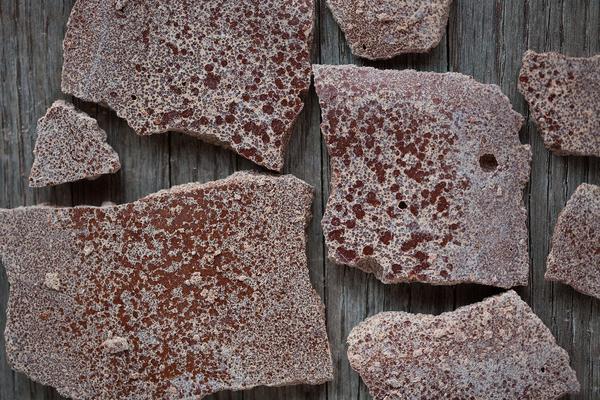Chocolate blooming. We’ve all had it happen. We open up a piece of chocolate, excited for the sweet joy that is awaiting us, and come to find that there is a hazy white coating on our beloved candy. What is this coating? Did your chocolate “go bad”? Can you still eat it or even cook with it?
This phenomenon is known as chocolate bloom. Although bloomed chocolate is still safe to eat, it does pose some aesthetic and textural problems that might detract from your chocolate experience. But what really causes this unappealing appearance? Is it a sign of poor quality or improper storage?
Let’s explore the science behind bloom on chocolate, exploring both its types—fat bloom and sugar bloom—and how they affect your favorite treat.
 Breaking Down the Bloom on Chocolate
Breaking Down the Bloom on Chocolate
Bloom: the plague of the chocolate world and the bane of every chocolate lover’s existence. It’s unsightly, can affect chocolate texture, and can even subtly impact the way chocolate tastes. But what is chocolate bloom? And how can it be prevented? Before you consider discarding that “frosty” chocolate bar, let’s demystify the truths and myths surrounding bloomed chocolate.
This whitish coating, often mistaken for mold, is one of the primary concerns in chocolate production and storage. There are two distinct types of bloom: fat bloom and sugar bloom. Despite their differences, both types of bloom on chocolate occur due to less-than-ideal storage conditions rather than through any fault in the production process itself.
Fat Chocolate Bloom
Fat bloom is the most common type of bloom. It is typically caused when chocolate is exposed to fluctuating high temperatures and then allowed to cool and reset improperly. Have you ever left a chocolate candy bar in the car on a sunny day? If so, you might have noticed a pale, whitish coating on the chocolate once it cooled down. This is a classic example of fat chocolate blooming.
Here’s what happens. The cocoa butter inside your chocolate melts and, if the chocolate cools in uncontrolled conditions, it can separate from the sugar and the rest of the solid ingredients. As it solidifies in a warm environment that is not properly managed, the cocoa butter rises to the surface and settles, thus creating that characteristic off-white chalky appearance.
Sugar Chocolate Bloom
Sugar bloom, on the other hand, is triggered by excess moisture. When chocolate is stored in a damp environment, the moisture on the surface dissolves some of the sugar. As the moisture evaporates, it leaves behind a rough, speckled crust of recrystallized sugar.
Sugar bloom can affect the aesthetic appeal of chocolate and also compromise its mouthfeel. The grainy texture that results from the crystallized sugar can detract significantly from the luxurious, melt-in-your-mouth experience that high-quality chocolate is known for.
What is the Impact of Chocolate Bloom on Flavor & Shelf Life?
While unsightly, bloomed chocolate does not render treats inedible. It does not affect the safety or the essential flavor profile of the chocolate. The altered texture, however, might detract from the pleasure of eating it. Chocolate with bloom is still perfectly fine to eat and can be used in cooking and baking where the appearance and texture are less critical than in a candy bar meant to be savored on its own.
How to Preventing Bloom on Chocolate?
The best way to avoid both types of bloomed chocolate is to store your sweet treats in a consistently cool, dry place away from direct sunlight. The melting point of chocolate is between 86 and 90 degrees Fahrenheit, so you’ll want to keep chocolates in a location that maintains a temperature above 65 and below 75 degrees.
You can read our blog for tips on how to keep chocolate fresh, but in short, the best hiding spot is in your pantry closed inside an airtight tin or smaller dark container, away from sources of moisture like kitchens or areas prone to steam. Proper storage will not only preserve the delightful snap and glossy sheen of your chocolate but also help maintain its rich flavors and intended textures.
Bloom-Free Chocolates
By understanding the basics of chocolate blooming, you can ensure that your chocolate remains as enjoyable as the day it was crafted. Whether you’re a casual snacker or a connoisseur, keeping your chocolate in optimal conditions will enhance your treat-eating experience. Remember, the key to preserving the pristine condition of your chocolate lies in controlling its exposure to air and moisture.
At the end of the day, you can rely on Asher’s Chocolate Co. to make chocolate of the highest quality. We go through a strenuous and detailed process to ensure that our products are tasty and chocolate bloom-free! To get all of your favorites, give us a call at 855-8-ASHERS, or visit us online!